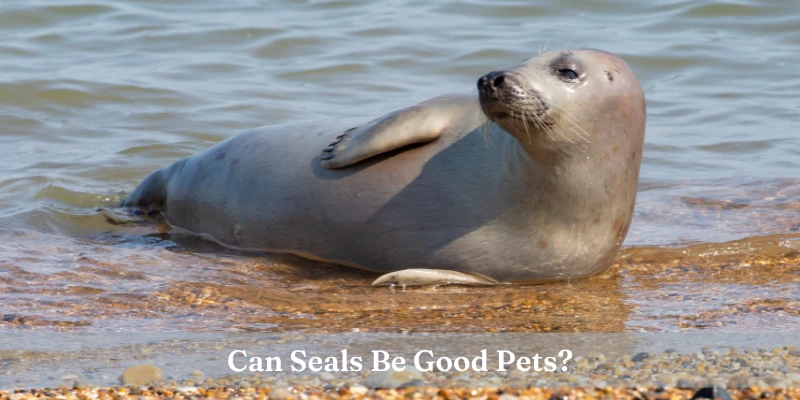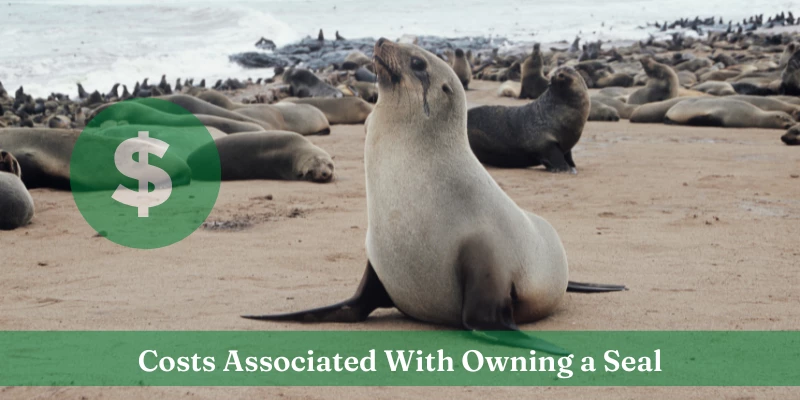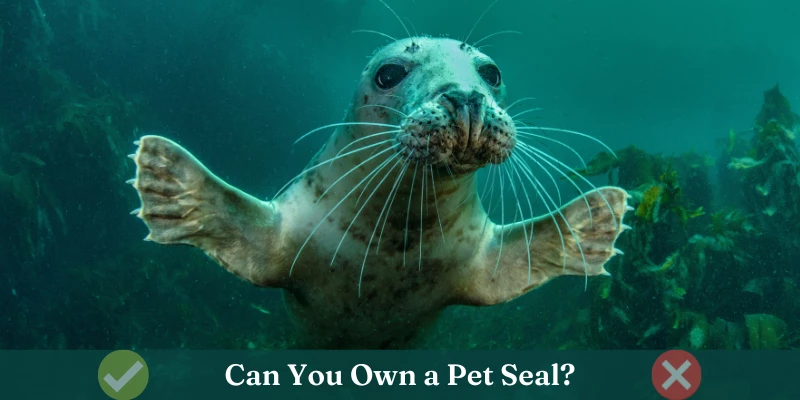Considering the prospect of having a seal as a pet? The idea is intriguing, but it’s no small undertaking.
Let’s start with a splash of facts about seals: there are 33 distinct species of seals, scientifically known as pinnipeds, populating our planet.
In their natural habitat, seals boast an impressive lifespan of up to 30 years. Ranging in size from 3 to 20 feet and weighing anywhere between 100 pounds (45 kg) to an astounding 4 tons (3,629 kg), these marine mammals are truly diverse.
Seals can be found inhabiting various regions across the globe, with a particular affinity for cold-water environments. Their physical dimensions fluctuate based on their species, geographic location, and age.
Now, the burning question: Can You Keep a Seal as a Pet?
The answer is yes, but be prepared for an aquatic adventure of epic proportions. A prerequisite for seal ownership is a colossal saltwater pool, not to mention a constant supply of essentials throughout the year. Maintaining a pet seal demands a substantial financial commitment to ensure their nourishment and overall well-being.
Undoubtedly, caring for a pet seal is no walk in the park. It requires dedication, resources, and a genuine passion for these remarkable creatures. So, if you’re up for the challenge, the journey into the world of pet seals awaits with both excitement and responsibility.
Contemplating the whimsical notion of adopting a seal as your next exotic companion? Dive into the aquatic adventure, but beware—it’s not a venture for the faint-hearted or the financially faint.
Seals, those flippered marvels, are no lightweights when it comes to dining. Picture this: a seal weighing in at a robust 800 pounds (363 kg) demanding a daily feast of 40 pounds (18 kg) of fish. It’s a marine gastronomic extravaganza that could leave both your wallet and a fish market depleted.
Navigating the legal waters:
Can I Have a Seal as a Pet in the United States?
Indeed, you can, but the catch is colossal. Your aquatic amigo will need bespoke accommodations—a saltwater pool, a pebble beach, and a fishy feast. Seal life is both wet and dry, and their habitat should reflect this unique duality.
Can I Have a Seal as a Pet in the UK?
In the UK, where commercial intents with seals are a no-go, the exotic pet status of seals seems to swim in murkier regulatory waters. Dive into the Marine Species & Wildlife Protection bill for the finer details of seal ownership decorum.
Can I Have a Seal as a Pet in Australia?
Down under, the EPBC Act holds a stern stance against seal-related activities. Yet, the waters become muddied with state legislation. Check your state laws, but keep expectations in check—the EPBC Act isn’t waving a welcoming flipper.
Before you take the plunge into seal parenthood, consider the following:
- Pet Seal Habitat: Think grand—picture a colossal saltwater pool and a pebble beach. Seals need both aqueous and terra firma space to live their best flippered lives.
- Pet Seal Diet: It’s a financial deep-sea dive. With a daily intake pegged at 5% of their body weight, an 800-pound (363 kg) seal would be dining on 40 pounds (18 kg) of fish daily. Scale that up for a year, and you’ve got a marine feast fit for Neptune.
- Pet Seal Behavior & Temperament: Seals aren’t your garden-variety pets; they’re sizeable, potentially testy, and capable of nipping. Domesticating them requires not just dollars but the talents of a certified seal whisperer.
In essence, the path to pet seal ownership is a unique and demanding odyssey. It’s not just about embracing a marine friend but navigating uncharted waters of commitment, cost, and charisma. Strap on your metaphorical scuba gear, for this journey promises a plunge into the extraordinary.

Contemplating the idea of making a seal your next furry (or rather, flippy) companion? It’s a tempting thought, but before you embark on a marine adventure with a pet seal, let’s explore the flip side of this flippered fantasy.
Can Seals Be Good Pets?
The allure of having a seal as a pet is undeniable, but the road to aquatic companionship is paved with challenges. The price tag for ensuring your pet seal lives its best marine life is no mere drop in the ocean.
5 Reasons Seals DO NOT Make Good Pets
- Seals Are Huge: Picture this: your pet seal falls ill, and the customary vet road trip is no option. Special transport or a wallet-draining vet house call becomes the new norm.
- Seals Require Special Habitats: Forget about bathtub antics; pet seals demand accommodations beyond the ordinary. A beach, a saltwater pool—luxuries that most of us can only dream of providing.
- Seals Can Be Dangerous: While seals prefer to keep their distance, their bites can spell trouble. Their size and potential for aggression mean handling them requires caution.
- Seals Are Mammals: Sharing mammalian status with humans means seals can play host to viruses like rabies and herpes. A health risk that could put a damper on the seal-owner relationship.
- Seals Are Predatory: Seals have a predatory streak. Without the right training, instincts might kick in, and the uncertainties of seal-human interactions come to the forefront.
6 Common Species of Seals
- Elephant Seals: Giants of the seal world, with males tipping the scales at over 8,000 pounds and stretching over 20 feet.
- Fur Seals: Adorned with thick fur, males boast a significant 7 feet in length and 600 pounds in weight.
- Gray Seals: Ranging around 10 feet for males and 7.5 feet for females, with adult males weighing a substantial 900 pounds.
- Harbor Seals: Humble in size, reaching 6 feet and 300 pounds for adult males, with Pacific counterparts typically larger than Atlantic kin.
- Harp Seals: Sporting a snout with a small head, these seals grow to 5-6 feet and can weigh close to 300 pounds for males.
- Leopard Seals: The serpentine giants, stretching to 10 feet and weighing 1,300 pounds, with females surpassing males.
In essence, the fanciful notion of having a seal as a pet demands more than just a love for marine life—it demands deep pockets, logistical prowess, and a readiness for the unexpected. The journey into seal companionship is a unique odyssey, where whimsy meets reality in the aquatic realm.

The Enchanting World of Pet Seals: A Symphony of Elegance and Expense
In the realm of unconventional companions, the elusive pet seal stands as a testament to luxury and maritime grandeur. To embark on this aquatic odyssey is to tread upon a path of opulence and responsibility, where the ethereal meets the tangible.
🌊 The Aquatic Abode: First and foremost, behold the majestic saltwater pool—a liquid kingdom tailored for your sophisticated seal. Its cost, a reflection of aquatic extravagance, ranges from $25,000 to $80,000. This is not merely a pool; it’s a marine haven where your seal can revel in the dance of the waves.
As we traverse the shoreline of our seal’s sanctuary, the pebble beach emerges—a pristine stretch of elegance costing between $5,000 to $10,000. Picture your seal basking in the sun, the symphony of pebbles beneath its flippers composing a sonnet of serenity.
🍽️ Culinary Couture: Ah, the pièce de résistance—culinary indulgence. The annual feast for a 200-pound seal oscillates between $25,550 and $54,750. A seemingly extravagant affair, but let us unravel the feast’s tapestry.
Picture a daily banquet: 10 pounds of the finest fish, a dance of flavors, and a ritual of sustenance. The U.S. salmon market, with its $7-$15 per pound cadence, weaves the fiscal symphony of sustenance for our aquatic connoisseur.
The Daily Delicacy Ballet:
- 10 pounds x $7 (USD, low end) x 365 = $25,550
- 10 pounds x $15 (USD, high end) x 365 = $54,750
Yet, even with a mythical “guy” on the scene, the cost of piscatorial extravagance remains a testament to the discerning palate of our aquatic companion.
🌟 Seal Acquisition Odyssey: The acquisition of a pet seal is a saga worthy of maritime lore. A best-guess valuation places the initial investment between $5,000 to $10,000, an entrance fee into the exclusive club of seal aficionados.
But, my fellow adventurer, this is not where the journey concludes; it’s a prelude to the grand symphony of seal companionship. A financial sonnet awaits, a melody of expenses that demand our acknowledgment and understanding.
🚫 Petting Protocol and Majesty: Gazing upon a seal from afar, an artistry of admiration, unveils their wild majesty. Attempting a beachside rendezvous with these marine sovereigns, while tempting, unveils the ballet of danger—especially in the presence of a maternal guardian.
Beyond the allure, seals, as brethren of mammalian lineage, harbor a potential exchange of not just charm but also diseases. Let us, then, celebrate these denizens of the deep from a respectful distance, allowing them the poetry of their natural existence. 🌊💙
In the opulent saga of pet seals, where waves and whims converge, one finds not just a companion but a voyage into a world where extravagance meets the allure of the untamed sea.
